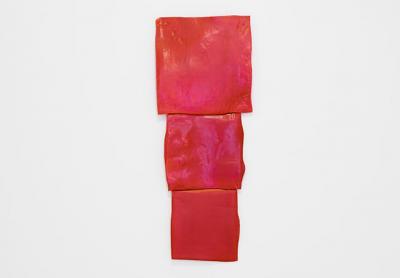Mary Heilmann’s Day-Glo Universe in Bridgehampton

Sure, the brightly hued wall sculptures and paintings of Mary Heilmann looked more fitting at Dia’s Dan Flavin Art Institute during the summer, but the shot of infectious cheerful color is just what we need on these gray days. The fact that they harmonize with Flavin’s fluorescent sculptures upstairs doubles the dosage of this balm for seasonal affective disorder.
This group of pieces, mostly from the past year or so, include the lively “A Row of Cups and Saucers” and several two-dimensional works. The artist works small, but her choice of acrylic colors packs a powerful Post-Minimalist punch.
Her two early works, “The First Vent” from 1972 and “Rio Nido,” demonstrate an earlier, more detailed presentation than the pure sectors of color in her later work. “The First Vent” even resembles a vent in an abstracted, memory-of-an-object kind of way. The exhibition brochure notes that she loosely drew the vent in the same scale as the vents in her studio. Inspired by Donald Judd, she has said that she found his references to real and domestic objects significant to her practice.
The vent, a piece of metal hardware not far removed from forms the Minimalists used as their subjects, becomes undulated and blurry in her hands, literally, as she used her fingers to paint the lines, giving it a more individualized interpretation. In this early work she chose to paint on a “rectangular plane” to be “placed flat against the wall,” i.e., the main thing Judd found wrong with painting. This decision shows both an adherence to and a thumbing of her nose in real time at some of the stricter Minimalist doctrine.
“Rio Nido” from 1987 looks much closer to her later work, a divided field but still on one contiguous surface. The blobs of color in its field of black that have traveled over from the surrounding sections were excised in future paintings. Ms. Heilmann comes from Northern California, and her attachment to bright, West Coast-inspired colors seems not to have been dulled by her years of East Coast residency.
As she told The Star in 2017, she began coming here in the 1960s, first at the invitation of Bruce Nauman, who spent a summer working at Roy Lichtenstein’s house, then rented in Springs and Wainscott in the ’80s and ’90s, before setting her sights on the house and studio in Bridgehampton that she has lived in since. “Rio Nido” refers to a beach town from her home state, but the composition was prompted by her reacquaintance with the ocean here.
Her own house is essentially around the corner from the renovated firehouse (originally a church) that has become the Flavin Institute, which she passes on the way to the beach. Two of the works in the show, “Red Mirage” and “Green Mirage,” were inspired by Flavin’s “Icons,” his early work that began incorporating light fixtures into flat wall pieces that were not quite paintings and not quite sculptures.
Like Flavin’s “Icons,” Ms. Heilmann’s “Mirages” play with strict Formalism, using painted wood pieces placed over painted canvas to give the surface of the paintings an uneven and sculptural quality. The horizontal bands of color that the painted wood additions partially obscure recall Flavin’s later and best-known works, formed from horizontal bands of fluorescent lights, which can be seen in the loft.
Not afraid to address the religious overtones of the “Icons” in comparison, she has admitted that her Catholic upbringing has infused her work. The building’s original use as a church adds to the resonance. Given all of the associations, these pieces look especially at home here.
There are a few other works on view, including “Red Metric,” a ceramic piece from 2015 that shows the artist’s loyalty to one of her earliest mediums. Unlike the cups and saucers lined up on the wall, this sculpture alludes to no utilitarian function. Its raison d’etre is to explore the visual possibilities of red glazes, challenge the rules of gravity, soften the edges of the square into a more freeform interpretation, and indeed make something intended to be placed flat against a wall. Ms. Heilmann may have matured since her salad days at Max’s Kansas City, but her young turk attitude (“say something rude and clever and scare the shit out of them,”as she told The Star in 2016) still burns bright.
The exhibition will remain on view until Memorial Day.
